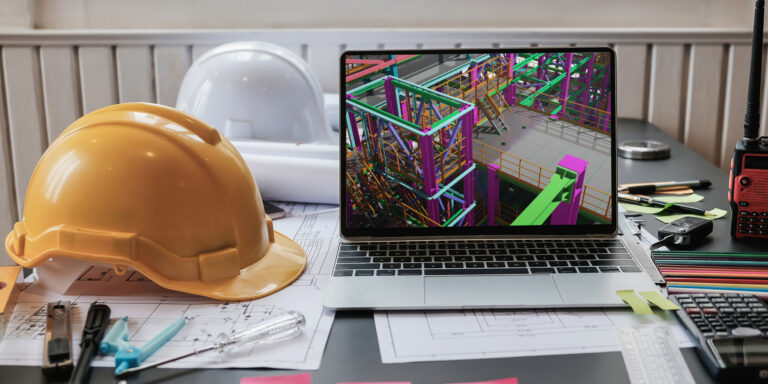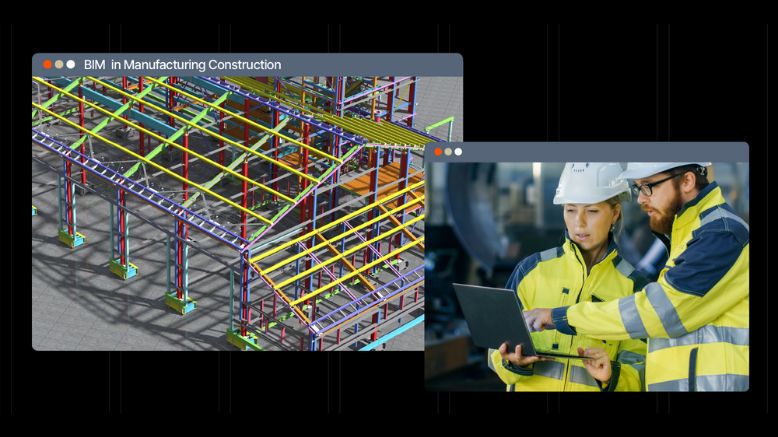— 7 min read
BIM Manager: Where Technical Construction Expertise & People Skills Meet
Last Updated Nov 15, 2024
Last Updated Nov 15, 2024

General contracting companies and trade partners increasingly rely on 3D models to inform their work. As a result, the implementation of building information modeling (BIM) has been expanding, particularly on larger-scale projects.
Because of the increasing use of BIM in construction projects, firms are hiring more roles that manage BIM. Working as a BIM manager could be an ideal fit for someone who likes problem-solving, has strong coordination and communication skills and wants to stay on the leading edge of construction technology.
In this article, we will look at the role of a BIM manager, exploring what BIM management is, the day-to-day responsibilities of a BIM manager and the path to getting started in this field.
Table of contents
How Organizations Approach BIM Hires
In the 2010s, BIM was getting a lot of buzz in the construction industry. General contractors (GCs) took notice and some built large BIM departments. However, ineffective management and a lack of integration with the project team caused some of these teams to crash and burn. In response, many GCs wiped out their BIM groups.
Trade partners, on the other hand, have seen continued success with investing in BIM. As project timelines tighten, BIM gets particularly important because it enables better prefabrication. With a trustworthy model in place, trade partners can prefabricate systems so they fit and function precisely as needed once installed on site.
Pair the trades’ success with BIM with an increasing owner interest in modeling, and many GCs have circled back to this field. Some firms have started building internal BIM teams again, albeit at a slower and more careful rate than a decade ago.
Each company has its own definition of the BIM manager role and the responsibilities that fall under it. Generally speaking, though, the BIM manager is tasked with leading projects’ coordination efforts based on both the 3D model and its associated 2D documents (i.e., drawings and specifications).
The way the company structures that role depends on the company’s structure and specific needs. There’s generally variation in the following areas.
Team Structure
At some companies, the BIM manager heads their department, with other roles like BIM specialists, coordinators, or assistant BIM managers under them. In this case, the BIM manager’s role is overseeing the team under them. In other instances, the BIM team is only one or a few people, all on the same level, each tasked with overseeing BIM management on specific projects.
Organizational Structure
he BIM manager might be a hire within any number of the company’s departments, including construction technology, preconstruction, operations, or even IT.
Purview
Some companies assign one dedicated BIM manager to each specific project. Others have BIM managers oversee multiple projects running in tandem. The number of projects for which the person is responsible usually correlates to the size and scope of the project(s). One BIM manager might only manage one large, involved project, for example, while another person oversees three smaller projects at the same time.
Job Growth
Historically, the career trajectory for BIM managers has been fairly flat. As the use cases for BIM evolve, though, some companies have developed career paths that allow individuals to grow from BIM coordinators/specialists to BIM managers and eventually Directors of BIM.
No matter how the role is structured within the company, the BIM manager generally needs to interface with both their own organization’s internal teams and external partners (e.g., specialty contractors, if the BIM manager works for a GC).
Typical BIM Manager Job Responsibilities
BIM managers usually work in tandem with the project management team. At they same time, they collaborate with other key members of the construction project team, like field supervisors and trade partner foremen. It’s their responsibility to create the model for the project, integrating input from other parties, then to keep that model continually updated.
Using the model, the BIM manager might:
- Run clash tests
- Review for constructibility
- Facilitate coordination
- Make updates as needed
- Use other tools (e.g., laser scanning, 360-degree photo capture) to inform the model
- Train internal team members on how to leverage BIM
A large part of a BIM manager’s role centers on preparing for and running meetings. In preparation, they likely need to review the model and any open issues, make updates and gather additional information. This way, when everyone gathers at the meeting table, the time and the model can be used effectively. It’s also the BIM manager’s responsibility to capture and move on action items from the meeting. They may need to review a submittal, make the specified changes to the model and pass that information to the coordination team, for example.
Some firms also tap their BIM managers to help them pursue projects. Modeling the project — and the resulting visualization the model enables — can be a valuable asset that helps the company stand out from the competition.
Finally, as someone who’s seen as a technical expert at their organization, the BIM manager might be asked to help with other tech-related tasks, too.
Key Skills for a BIM Manager
To succeed as a BIM manager, people generally need competency in the following three areas.
1. Soft Skills
A large part of a BIM manager’s job centers on getting teams to communicate what’s needed to make the model effective, and then to collaborate to use that model to its biggest benefit. All of that requires getting people on the same page and listening to one another. As a result, strong communication and interpersonal skills go a long way for any BIM manager.
2. Technical Capabilities
To work with building information modeling, individuals need knowledge of the software solutions used to create and manage the resulting models — and to coordinate from them. This usually requires familiarity with a handful of different tools, which are evolving as different software providers bring new solutions and features to the table.
3. Construction Understanding
BIM software can often be learned in a matter of months, but a deep understanding of the processes required to complete a construction project often takes years to develop. A BIM manager risks falling into an overreliance on the model without that knowledge base, though.
There are, for example, some things that won’t be captured in the model or some issues the model won’t detect. Strong BIM managers use the model in tandem with the project’s 2D drawings to inform their coordination efforts.
BIM managers without a construction background benefit from spending time in the field to understand how contract documents affect the model. Field experience also helps them learn processes like RFIs and submittals and how a project generally comes together.
BIM Manager Degrees and Certifications
New career paths are starting to open up in the realm of BIM management. Some companies now hire for entry-level BIM roles like BIM coordinators. Students interested in a career working with building information models can seek out BIM-focused degrees at higher learning institutions like:
Additionally, the Associated General Contractors of America (AGC) offers a Certificate of Management - Building Information Modeling (CM-BIM).
People new to the world of BIM — and particularly to the world of construction — may benefit from looking for roles at companies with a well-established BIM team. This way, the individual can learn the processes and best practices in use today while gaining construction industry experience. Later in their career, they’ll be better equipped to explore going to a smaller company and helping them build a BIM team.
Courses about construction.
For construction.
Unlock your career potential with our free educational courses on Health & Safety, Data in Construction, and more.
Overcoming Common Challenges for BIM Managers
BIM management is a growing field, but that doesn’t necessarily mean project teams are readily integrating BIM and the people powering it. In fact, there’s still a persistent problem across many organizations: the BIM team often isn’t thought of as part of the project team. Because they may not be on-site every day, they can fall out of the loop on what’s actually happening with the project. Other stakeholders may feel that BIM management is a box they merely need to tick so they can move on.
To combat this, any BIM manager can benefit from being physically on the project as much as possible. Whenever it makes sense to run meetings from the jobsite, do so. Be one of the first people to show up, and show up ready to work (i.e., in boots and a hard hat, not slacks and dress shoes). Walk the jobsite, talk with people in the field and engage directly with trade partners.
Through hard work and patience, BIM managers can move past simply being seen as an outside, loosely related player — and ideally into a role as a critical part of the project team.
Was this article helpful?
Thank you for your submission.
100%
0%
You voted that this article was . Was this a mistake? If so, change your vote here.
Scroll less, learn more about construction.
Subscribe to The Blueprint, Procore’s construction newsletter, to get content from industry experts delivered straight to your inbox.
By clicking this button, you agree to our Privacy Notice and Terms of Service.
Categories:
Tags:
Written by
DJ Phipps
DJ Phipps has spent over two decades working in the building and design industry. He's dedicated to using technology to make work easier and more efficient, with a focus on project management and improving systems. DJ now plays a key role at Procore as a Senior Principal Strategic Product Consultant.
View profileKacie Goff
54 articles
Kacie Goff is a construction writer who grew up in a construction family — her dad owned a concrete company. Over the last decade, she’s blended that experience with her writing expertise to create content for the Construction Progress Coalition, Newsweek, CNET, and others. She founded and runs her own agency, Jot Content, from her home in Ventura, California.
View profileExplore more helpful resources

The Role of BIM in Sustainable Construction
Building information modeling (BIM) is transforming the architecture, engineering, and construction (AEC) industry. With this kind of sophisticated modeling, the industry has shifted from designing in 2D to 3D. This helps...

Building and Using Large Data Sets with BIM
In recent years, two technological concepts have exploded, almost in parallel: One, called building information modeling (BIM), makes it possible for stakeholders to “build” construction projects in a 3D virtual...

Exploring BIM’s Potential in Manufacturing Construction
As building information modeling (BIM) improves, project owners can build more sophisticated facilities faster. And as consumers increasingly demand what they want delivered to them faster, brands need smarter manufacturing...

How BIM Enhances Control and Efficiency for Project Owners
Any construction project has a number of stakeholders. With a traditional project delivery method, it moves from designers and engineers in the architectural design process, to the general contractor and...